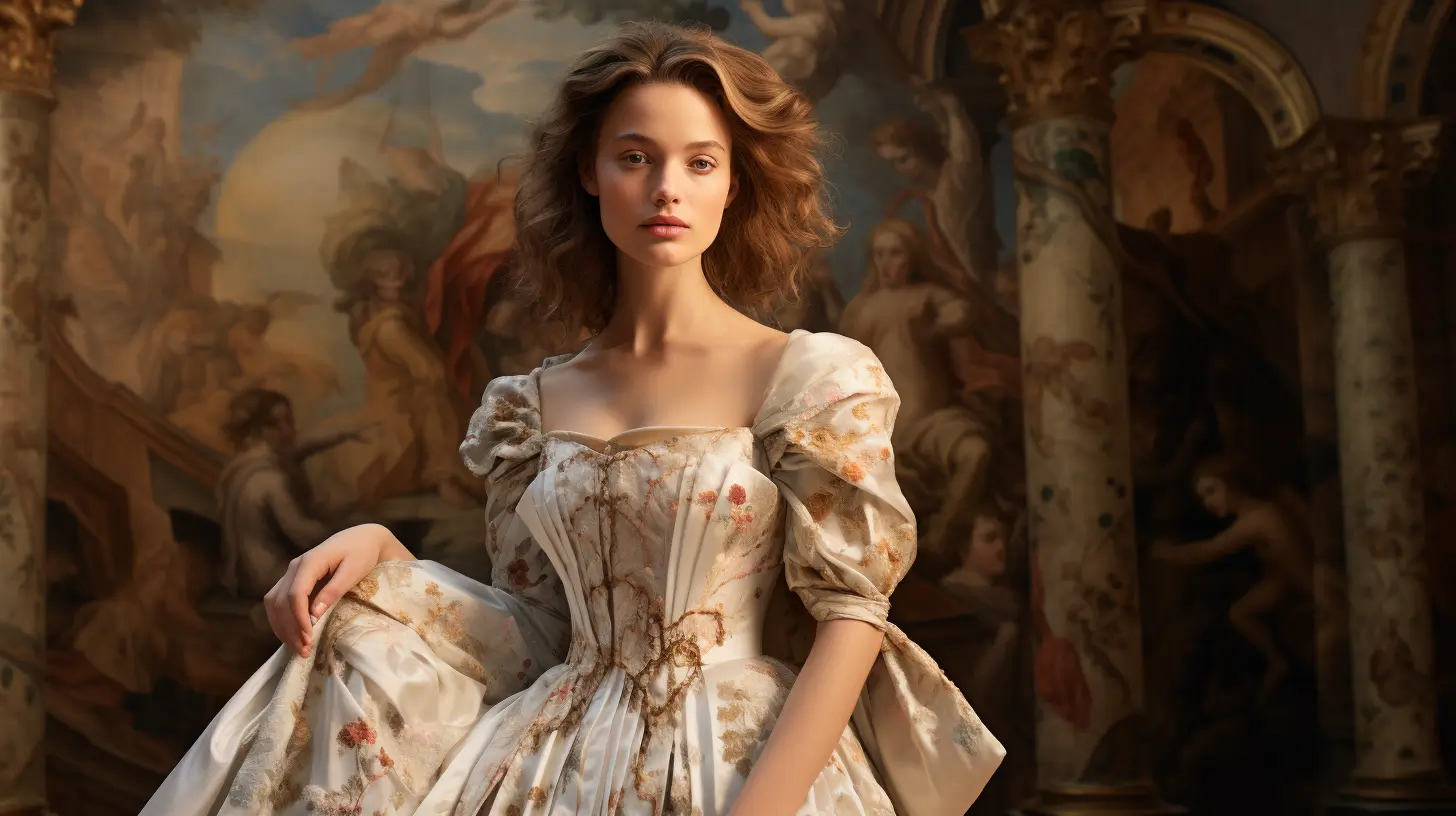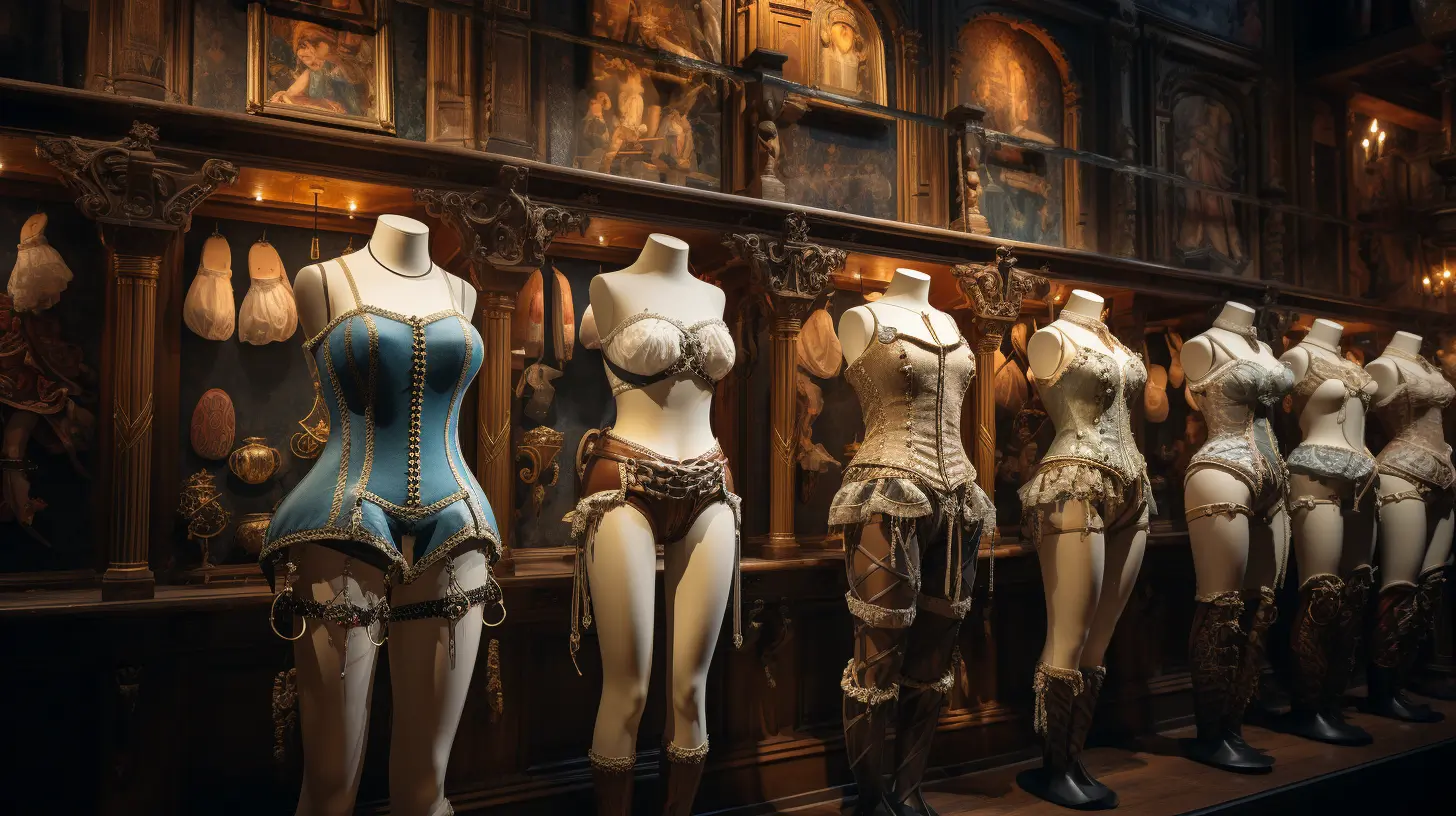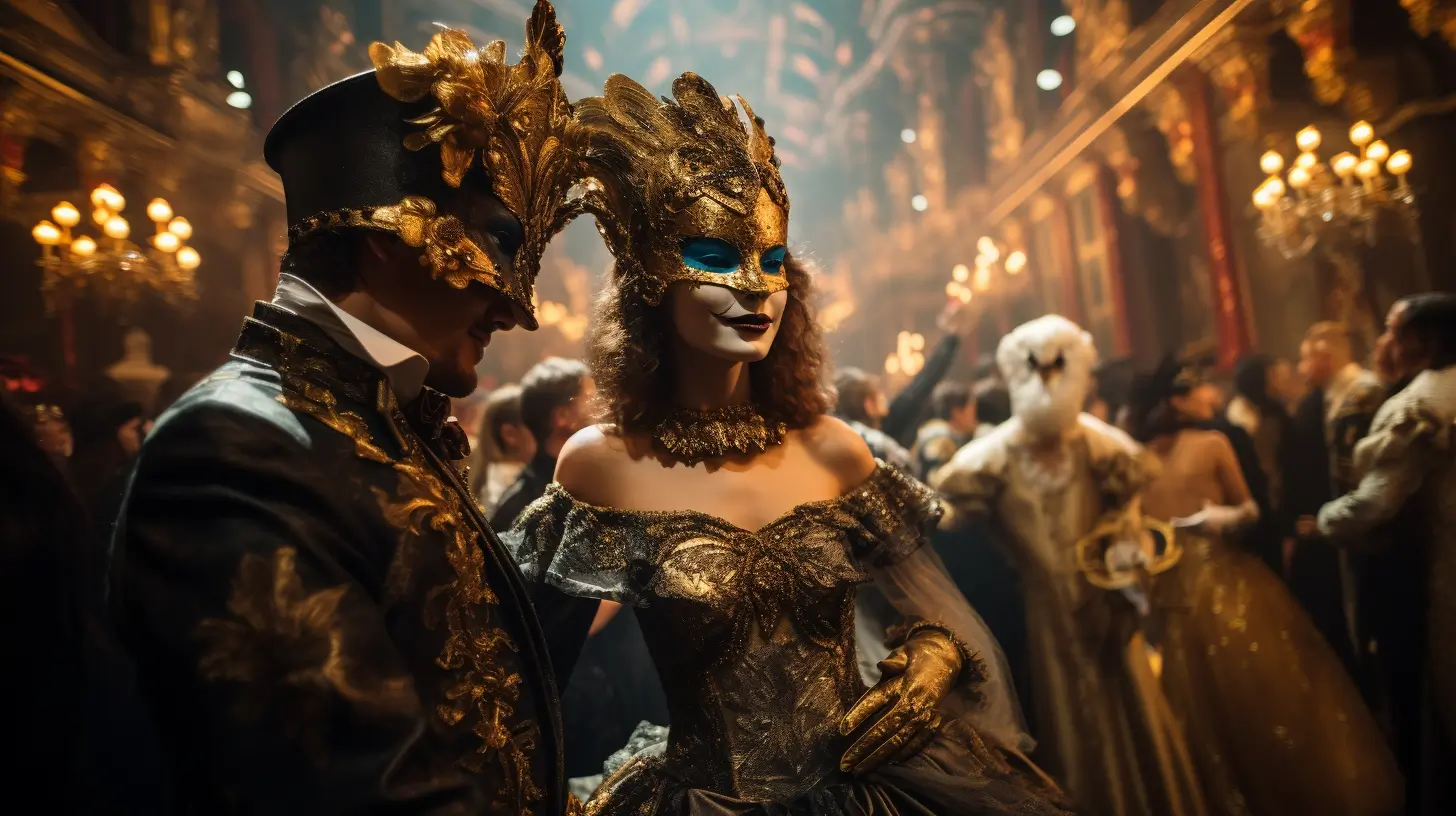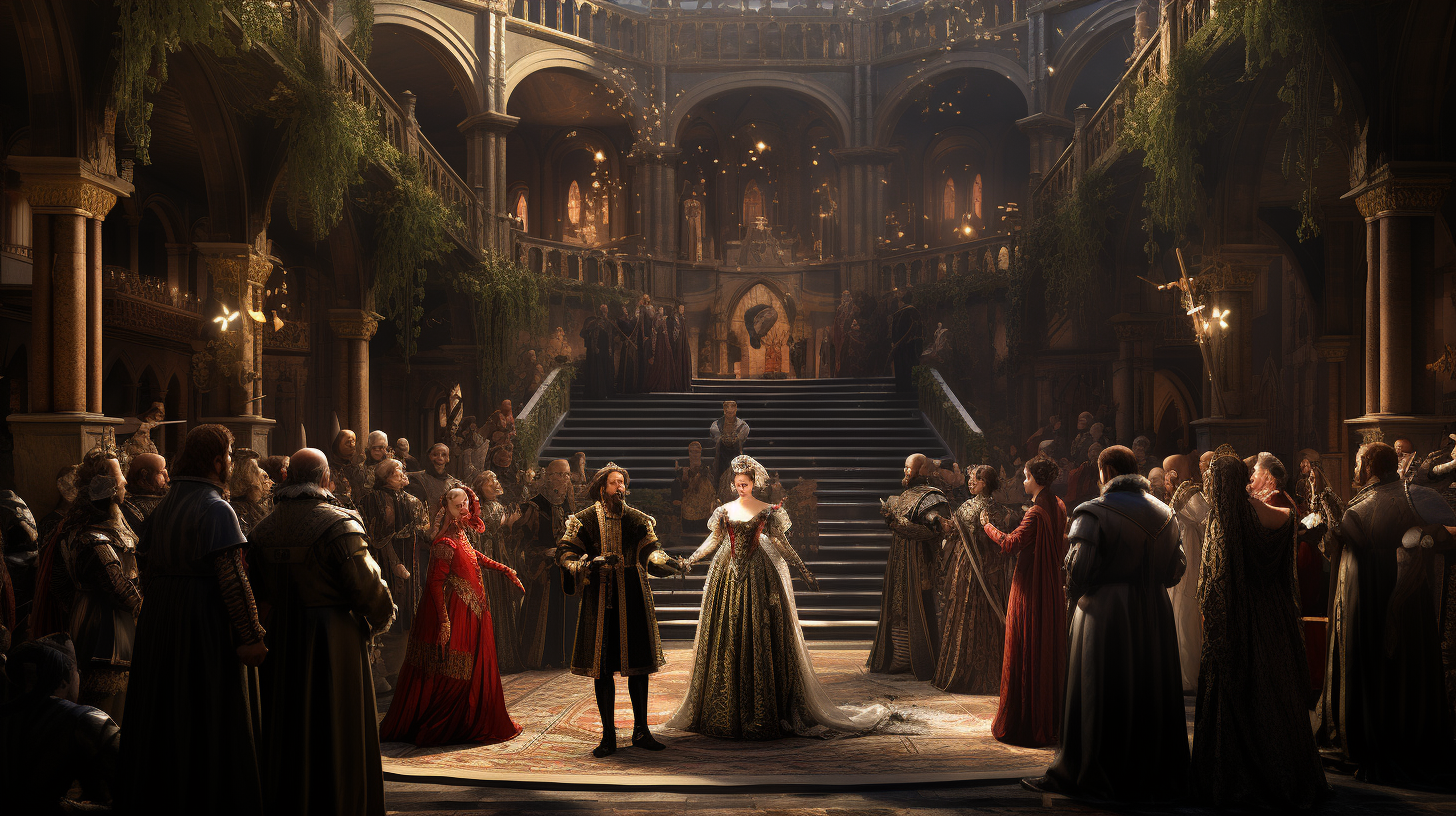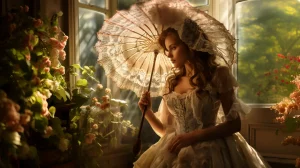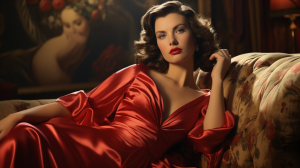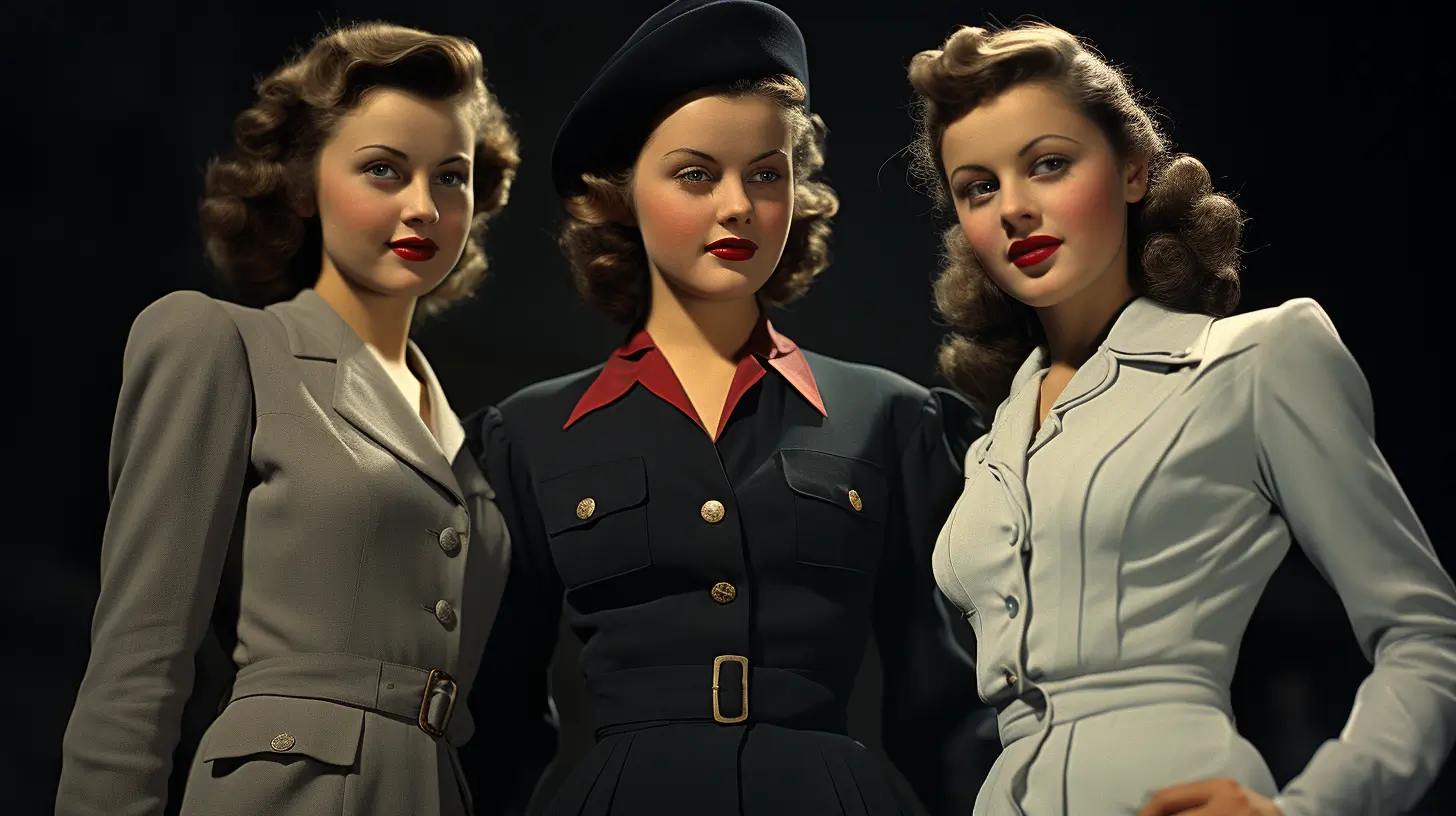
Utility to Beauty: The Transition of 1940s Women’s Fashion
A Stitch in Time: The Fabric of the 1940s Fashion Revolution
As the world turned on its axis, the 1940s unfurled a backdrop of tumultuous change. It was an era painted with the broad strokes of war yet finely detailed by the resilience and ingenuity of those who lived through it. Women stood steadfast at the heart of this epoch, their lives and fashions weaving together a narrative of survival and reinvention.
The World’s Stage Set for Change
It was a decade where the thunder of war echoed globally, rippling into every aspect of daily life. The once flamboyant frills and gaiety of the ’30s fashion scene were promptly tucked away, replaced by the stark reality of resource scarcity. This wasn’t just fashion evolving; this was 1940s Women’s Fashion adapting to a world at war.
The Frontline of Fashion
On the home front, women donned their armor. Sturdy fabrics replaced silks, and hemlines rose not for style but for saving. Every stitch counted, every yard of fabric a precious commodity. The government’s grip tightened around material use, ushering in the era of Utility clothing – practical, yet paradoxically, a canvas for creativity.
The Dual Role of Women: Necessity and Ingenuity
Women were not just keepers of the home but now guardians of industry. Their roles doubled, and so did their resolve. The war demanded practicality, so they delivered – with fashion that matched their new dual lives. Out of necessity bloomed innovation; skirts became sharper, and suits sharper still.
The Silhouette of Change
And then, as the war clouds cleared, a new silhouette emerged on the horizon. It was a whisper of beauty that would grow into a declaration – a post-war style that shaped not just the fabric but the very essence of the society it dressed.
This is the tale of transformation, a sartorial saga that saw the world pivot from the pragmatic Utility to the opulent ‘New Look.’ It’s a journey through the stitches that bound together a decade, a story of 1940s Women’s Fashion that mirrors the resilience of the women it adorned.
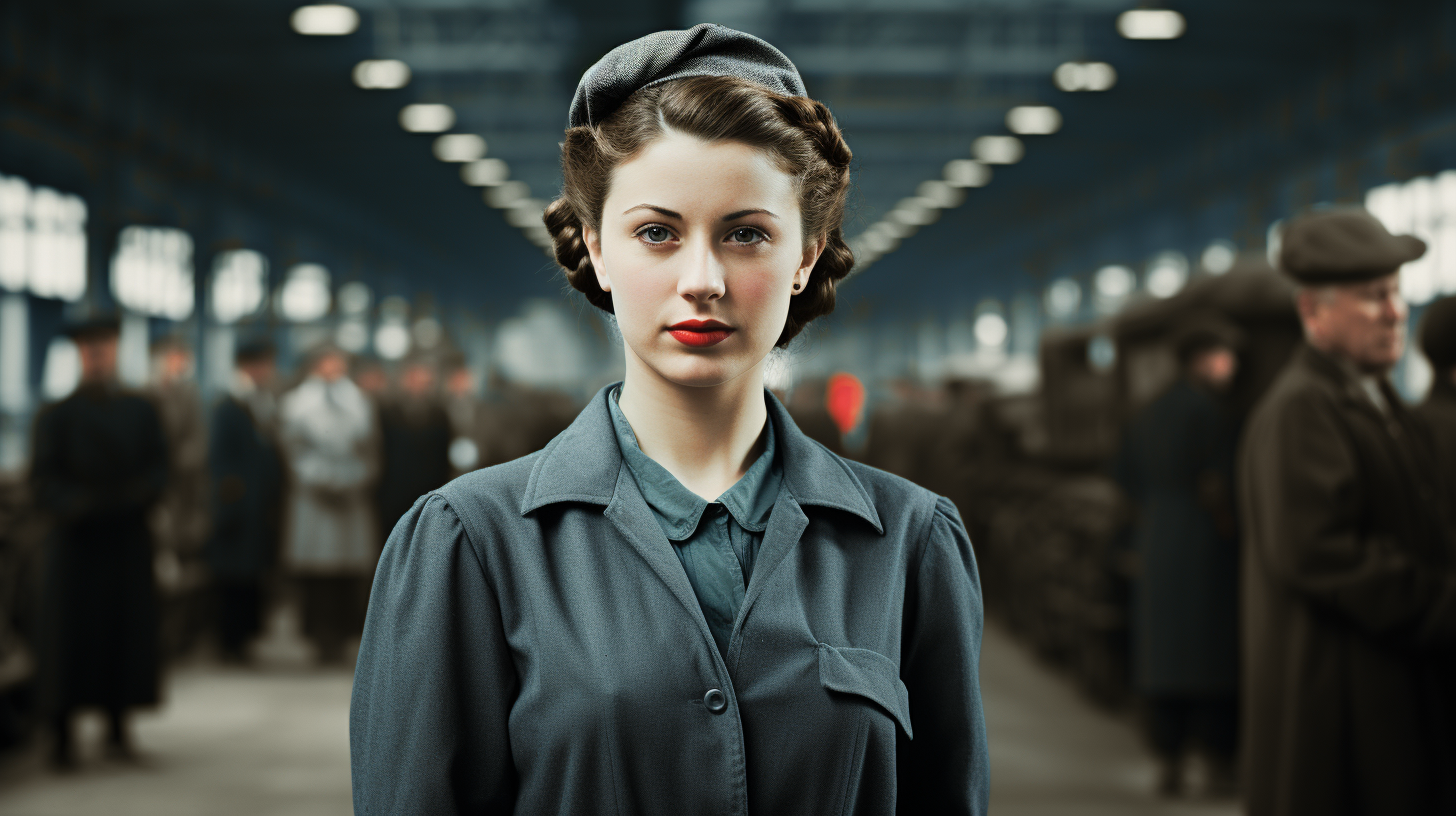
Fashion on the Ration: Wartime Restrictions
Wartime wasn’t just a battle of nations; it was a clash against the constraints of necessity. The world stage saw the introduction of a new character in the play of 1940s Women’s Fashion: austerity. This wasn’t fashion taking a back seat; this was fashion enlisting in the war effort.
Material Shortages and Their Creative Overcome
Let’s talk scarcity – not just a pinch, but a chokehold. Silk and wool were commandeered for parachutes and uniforms, leaving the civilian wardrobe scrounging for scraps. Yet, from this scarcity emerged a cunning resourcefulness. Rayon, sturdy and silk-like, stepped into the spotlight, and ‘Make-do and Mend’ became the day’s chant. Women turned blackout curtains into evening dresses and parachute silk into wedding gowns – a beautiful defiance in the face of shortage.
The Introduction of Utility Clothing
The Utility Scheme rolled out like a blueprint for survivalist chic. Designed by the Board of Trade, these weren’t just clothes; they were a morale booster packaged with belt-tightening efficiency. The government prescribed style details – no superfluous fabric, just straight lines and economic cuts. Utility clothing carried the ‘CC41’ label, a symbol that became a badge of both patriotism and fashion.
Rationing: Coupons and Quantities
You could say fashion had its own currency – the ration coupon. No cash could buy a new dress without the right amount of these little paper gatekeepers. Austerity dictated fashion, yes, but it also fostered an environment where every choice was a statement, every garment a carefully calculated decision. This was couture with a conscience, selections made with the weight of coupons in one hand and the balance of need and want in the other.
The Aesthetic of Austerity
Imagine the fashion runway as a battleground, where the aesthetic of austerity ruled. Clothing lines mirrored the lines of society – straight, no-nonsense, with a surprising grace under pressure. This was minimalist fashion before minimalism. Pleats and trimmings were out; simple cuts and functional styles were in. The silhouette became boxy and utilitarian, yet, beneath the utilitarian surface, a subtle sophistication thrived. The beauty was in the details – a clever dart, a discreet ruffle, a hint of defiance sewn into the hem.
The Workwear Revolution: Practicality Meets Style
The 1940s didn’t whisper; they roared with change. Women stepped into roles that were once the exclusive tales of men, and in this stride, they fashioned a revolution stitched in practicality and style.
Adapting Men’s Styles for Women’s Needs
As the world warred, women’s attire took on a militant stride. The soft curves of feminine fashion were tailored into the sharp lines of utility. The garb of the factory and the field borrowed from the locker rooms of their brothers, fathers, and sons. Overalls and boiler suits were reimagined for the feminine form, cinched waists battling with utility belts, all while maintaining a semblance of the style that whispered ‘woman.’
Rosie the Riveter: An Icon of Feminine Strength and Utility
Enter Rosie, with her biceps and bandana, a symbol who flexed more than just muscle. Rosie the Riveter wasn’t just a poster girl; she was an emblem of female fortitude, garbed in workwear that became a uniform for the empowerment of an entire gender. Her style was more than fabric deep – it was the embodiment of a capability that refused to be dimmed by circumstance.
Snoods, Turbans, and Headscarves: Functional Accessories
Then came the headgear – snoods, turbans, and headscarves – not just a fashion statement but a nod to necessity. Hair was a liability by the machinery, but these accessories turned safety into style. Wrapped, twisted, and tied, they crowned the heads of women who were as much at home in the factory as in the fashion avenue, their headscarves fluttering like flags of freedom and function.
The Emergence of Slacks for Women
And let’s not skirt the issue – the emergence of slacks was revolutionary. Pants were no longer just for the gents. Women embraced them, not just for their practicality but for the statement they made: equal parts comfort and liberation. Slacks were the sartorial embodiment of a shifting society, the drape of fabric over the leg a sign of changing times.
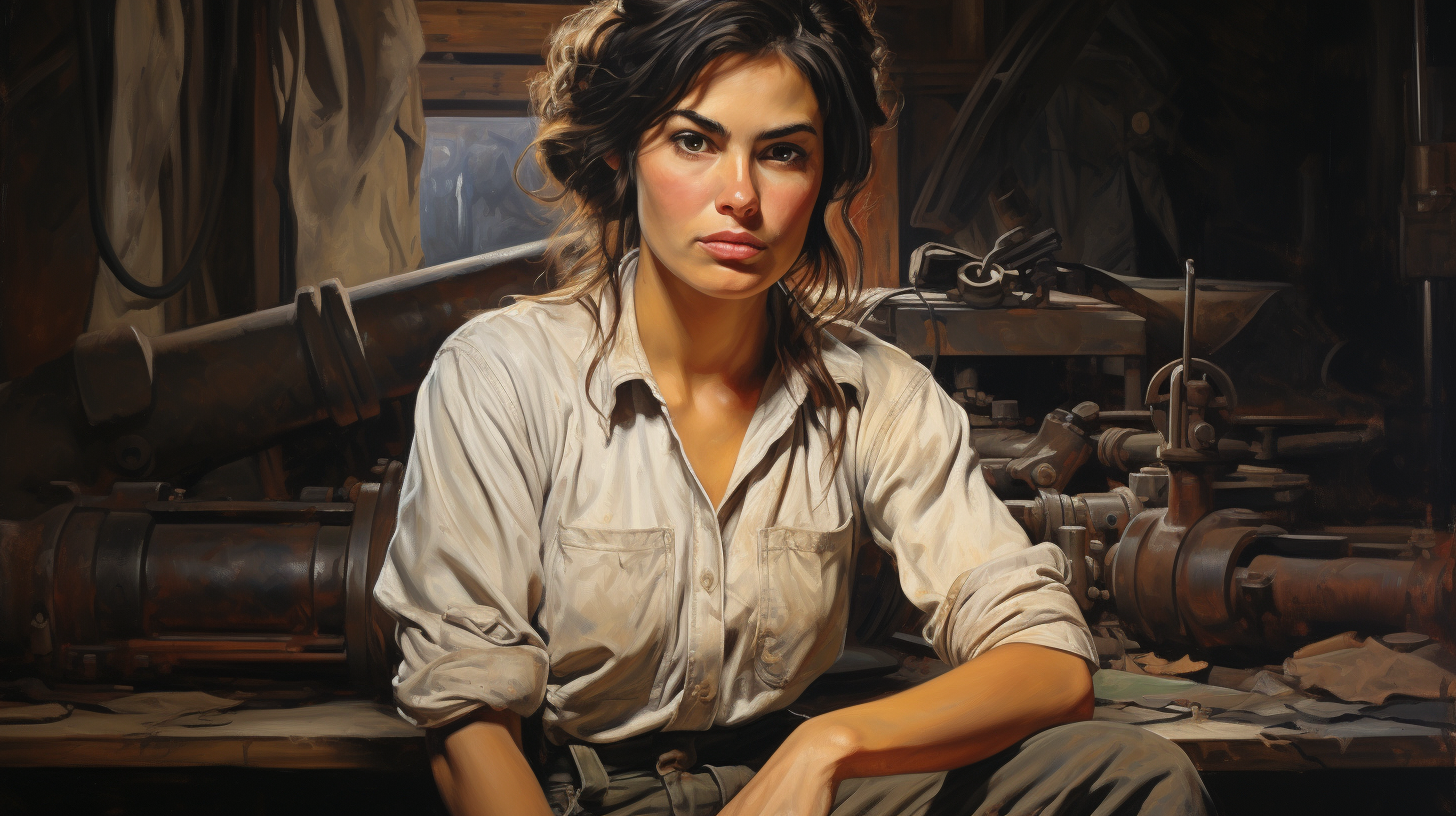
[image: 1940 era’s essence – a woman, poised with confidence, in a workshop– a modern Athena in a temple of machinery and moxie.]
Make-Do and Mend: A Culture of Resourcefulness
In an era when the new became a luxury and the old a necessity, the Make-Do and Mend campaign emerged not just as a slogan but as a way of life. It was a call to arms, or rather, to needles and thread. It spoke of resilience in the face of scarcity, and it brought out the MacGyvers of the domestic sphere.
The Government Campaign
The campaign was a beacon, illuminating the wartime darkness with the ethos of conservation. It was the government’s way of saying, “We can do this,” encouraging households to view the clothes on their back as a battalion in the fight for normalcy. Posters and broadcasts didn’t just ask for support; they offered a blueprint for personal resistance against the ravages of war.
Tips and Tricks for Making Fashion Last
Every thread counted. Every button was a bulwark against the onslaught of wear and tear. Women became wizards, transmuting old garments into new wonders. A frayed collar could be reversed, a worn-out dress disassembled and reborn as a child’s blouse. It was alchemy at the ironing board and wizardry at the sewing machine.
The Role of Magazines and Pamphlets
Magazines and pamphlets were the grimoires of the time, the spellbooks that turned old stockings into new purses. They were a wellspring of knowledge, disseminating patterns and advice. They spoke a language of loops and stitches, guiding hands weary from toil to find solace in creation, and offered a patch of beauty in a world patched with sorrow.
Homemade and Handcrafted Fashion
From this frugal soil sprouted the homemade and the handcrafted. It wasn’t just about making do; it was about making well. Hand-me-downs were transformed with embroidery and beadwork, a testament to the spirit that even in times of war, beauty would not be besieged. Women congregated not just to share patterns but to weave a tapestry of camaraderie, each stitch a connection, each seam a bond.
This was the sartorial embodiment of “keep calm and carry on.” And carry on they did, with a needle in one hand and a ration book in the other.
Beauty as Morale Booster: Cosmetics and Accessories
In the stark reality of the 1940s, amidst the cacophony of a world at war, cosmetics and accessories became silent heralds of hope and normalcy. Women wielded their makeup brushes like artists on a mission, daubing on color to face the drabness of wartime life.
The Role of Cosmetics in Wartime
Makeup wasn’t mere vanity—it was armor. A swipe of lipstick became a mark of defiance, a way to maintain self-esteem against the backdrop of uncertainty. The government, recognizing the lift a little powder could give to the spirits, ensured that lipstick and face powder, albeit in limited supply, remained in production. It was the face of perseverance, the rouge of resilience.
Jewelry and Patriotism: Tokens and Trinkets
Jewelry took on new meanings, becoming more than adornment—it was an emblem of remembrance and solidarity. A locket held a photo of a loved one serving far away, a brooch became a token of remembrance for those lost. Patriotism shone through in V for Victory pins, adorning lapels like medals of personal contribution to the war effort.
Accessories as a Means of Expression
With clothing constrained by rationing, accessories became the canvas upon which women could express their individuality. A vibrant scarf, a hand-crafted hat, or a pair of gloves were no longer just complementary pieces but statements of creativity and endurance. They became a language of style spoken silently but understood by all.
Innovation in Beauty Products
Necessity sparked innovation in the beauty industry. With traditional materials scarce, new synthetics and composites came to the fore. Beetroot doubled as a stain for lips and cheeks, while women learned to draw lines up the backs of their legs to simulate stockings when silk and nylon were diverted to parachutes and other war efforts.
In these times, beauty was not a frivolity but a necessity, a small but significant cog in the morale machine. It whispered a promise that normal days would return, and until then, there would be beauty, one way or another.
Transition into Peacetime: The War Ends
As the dust settled and the world exhaled the weariness of war, the fashion scene stood at the brink of a renaissance. The tides of change rushed in, sweeping away the uniformity of utility wear with a fresh, vibrant vision for the future.
The Immediate Post-War Fashion Scene
The end of the war was like a dam bursting. Elation and relief flooded society, and with it came an insatiable appetite for the new and novel. Women emerged from the shadows of austerity, eager to shed the constraints that had once defined their wardrobe.
Fabric Becomes Available – But At a Cost
The shackles of rationing began to loosen, and fabric—a former luxury—once again graced the shelves. Yet, abundance did not return overnight. Quality fabrics were still a luxury, often priced beyond the reach of those who had scrimped and saved for years. The marketplace became a paradox of possibility and scarcity.
Shifting Silhouettes: The Move Away from Utility
Fashion, once dictated by necessity, now danced to the tunes of freedom and femininity. The boxy, conservative lines of the 1940s began to give way to a nipped waist and fuller skirts, heralding the iconic silhouettes that would come to define the decade’s latter half.
The Desire for Colour and Flair
As if rebelling against the greyscale days of war, color returned with a vengeance. Patterns, previously considered frivolous, bloomed across fabrics. Women adorned themselves in hues that spoke of optimism—a visual feast after years of famine.
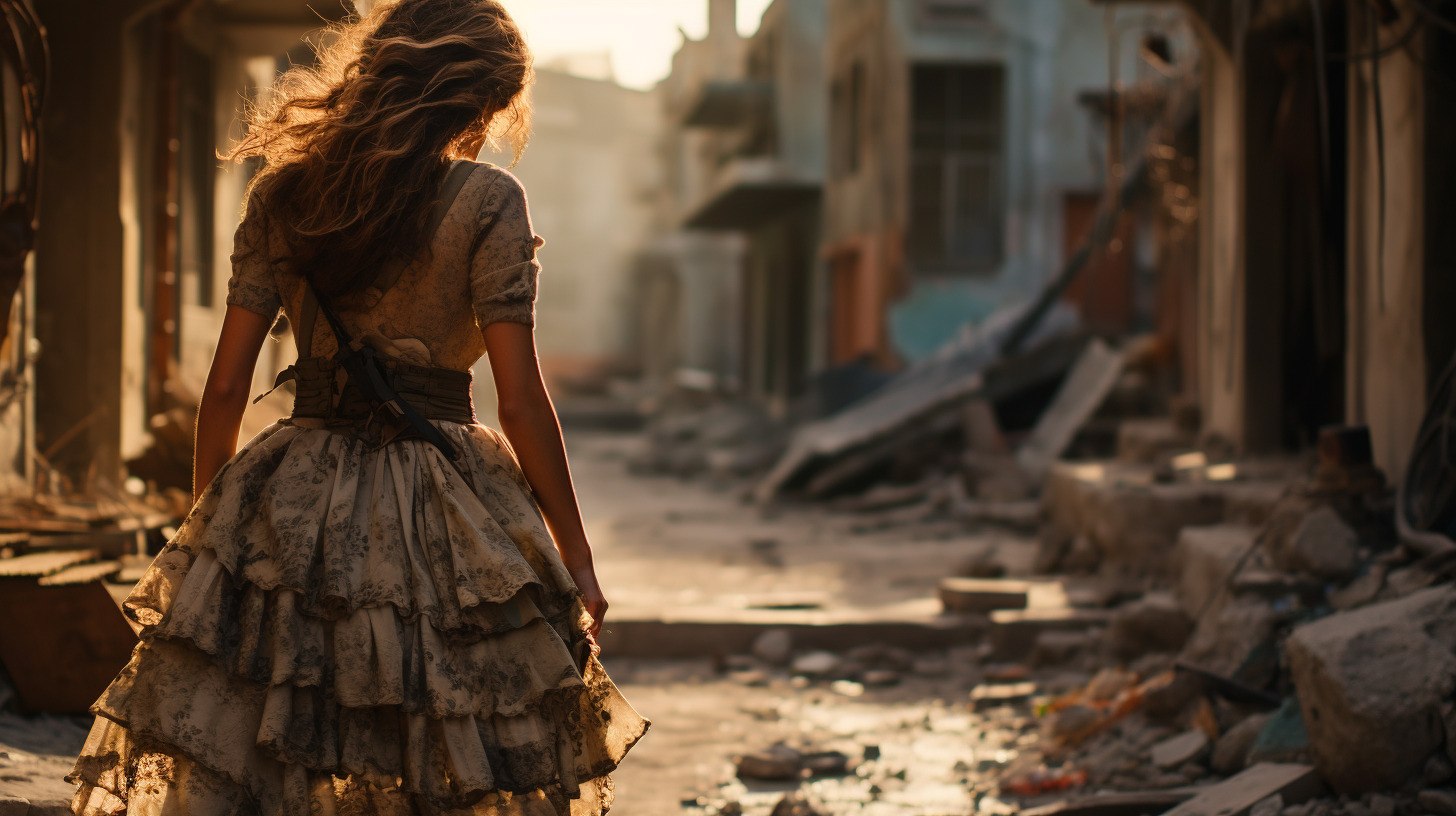
[Image: a woman standing at the threshold of a quaint, war-torn street. She’s captured in a moment of transformation,
the breeze fluttering a bright, patterned dress around her legs—a stark contrast to the drab backdrop. Her silhouette is changing,
right before our eyes, as she steps into a world where the streets are no longer lined with the shadow of war, but with the hope of peace.]
The ‘New Look’: A Fashion Revolution
In the epoch of rebirth that followed the war, a sartorial revolution was unfurling, spearheaded by a vision that would resonate through time and transform the ethos of women’s fashion.
Christian Dior and the Corolle Line
A certain Parisian designer, Christian Dior, introduced the world to his maiden collection, dubbed the “Corolle Line” but immortalized as the ‘New Look.’ It was more than just a collection; it was a bold proclamation that beauty and elegance were not just preserved for a serene world.
Defining Features of the ‘New Look’
This revolutionary style was marked by cinched waists, voluptuous skirts, and a silhouette that celebrated an exaggerated femininity. It was a stark departure from the conservative constraints of wartime attire, a sartorial symphony that sang of abundance and opulence.
Public Reception and Criticism
The ‘New Look’ was met with a maelstrom of emotions—hailed by many as a breath of fresh luxury, while others chided it for its perceived extravagance in a time of economic rebuilding. This contention only underscored its seismic impact on the fashion landscape.
The Global Impact on 1940s Women’s Fashion
The ripple effects of Dior’s creation were felt worldwide, redefining the parameters of style and inspiring a movement towards more elaborate, expressive forms of dress. The ‘New Look’ transcended borders, setting the global stage for a new age in women’s fashion.
Hollywood and Glamour: Escapism Through Fashion
In the aftermath of turmoil, the silver screen became a portal to a world of untainted glamour and allure—a place where everyday woes were cloaked in the opulence of cinematic fashion.
The Influence of Film Stars on Fashion
The charisma of Hollywood’s leading ladies wasn’t confined to the flickering frames of the movies. They were the unspoken arbiters of style, setting trends that spilled out from the theaters onto the streets. Their impact was immediate and far-reaching, stitching the dreams of the silver screen into the fabric of reality.
Glamour on the Silver Screen: Escaping Reality
Movies provided that much-needed respite from the austerity of wartime life, a visual feast for eyes starved of beauty. On-screen fashion was an exercise in fantasy, with actresses draped in the sort of elegance that transcended the harshness of the times.
The Contrast Between On-Screen and Real-Life Fashion
The chasm between the lavish costumes of film and the practicality of everyday attire was stark. Yet, this contrast did not go unnoticed—it stirred a yearning for elegance and became a driving force in the evolution of post-war fashion sensibilities.
Popular Films and Their Fashion Legacy
Certain films of the era became unintentional fashion documentaries, their legacy enduring far beyond their box office lifespan. The garments worn by their stars wove their way into the collective consciousness, often dictating the next season’s styles and embedding themselves into the cultural lexicon of fashion.
From Homemaker to Breadwinner: Fashion’s Societal Reflection
In the shifting tides of the post-war period, women’s fashion became the canvas on which a new societal narrative was painted, reflecting the evolving roles of women from homemakers to breadwinners.
Post-War Shifts in Women’s Roles
The return to peacetime saw many women reluctantly relinquish their wartime occupations, but the seeds of change had been sown. As they stepped out of factories, their newfound tenacity clung to the very fibers of their garments, hinting at the seismic shifts that were subtly reshaping society’s fabric.
Fashion Reflecting Independence and Freedom
With the war behind them, women embraced fashion as a symbol of their independence and freedom. Garments weren’t just about style; they were declarations of autonomy, with each stitch contributing to the larger story of women’s emancipation.
Subtle Changes Leading to the 1950s Transition
The late 1940s planted the tendrils of transformation that would blossom into the 1950s. Fashion began to capture this sense of transition, with subtle changes in cut and form preluding the full-skirted dynamism that the next decade would bring.
Feminine Identity and Style
Clothing choices became increasingly personal, a way for women to carve out their identity in a world still grappling with their role in society. Each outfit was a nuanced blend of the practical and the beautiful, an ode to the complex, multi-faceted identity of the post-war woman.
Icons of the Era: Women Who Shaped 1940s Fashion
As the 1940s carved its history into the annals of time, there were women who didn’t just wear the trends—they set them. Their influence shaped the fabric of the era, leaving an indelible mark on the world of fashion.
Designers Who Made a Difference
Trailblazers like Elsa Schiaparelli and Claire McCardell defied norms, weaving functionality with elegance. Their innovative spirits are etched in every line and seam, with designs that encapsulated the ethos of the era, driving fashion forward against the tides of adversity.
Famous Faces and Their Signature Looks
Screen sirens like Katharine Hepburn and Lauren Bacall brought a distinctive flair to the fashion scene, with Hepburn’s trousers and Bacall’s sultry suits blurring gender lines and defining sophistication. Their styles were more than just garments; they were a silent dialogue with society.
The Impact of Public Figures on Fashion Trends
Political figures and royalty, like Eleanor Roosevelt and the then-Princess Elizabeth, carried the weight of their roles not just in their actions but also in their attire. Their public appearances became not just a matter of protocol but a showcase of styles that resonated with the masses.
Style Icons Still Relevant Today
The impact of these icons is timeless. Names like Dior and Chanel remain embedded in the fashion lexicon, their influence perennially reborn in modern trends. Their legacies are worn by new generations, proving that true style knows no expiration.
Photorealistic Image Description
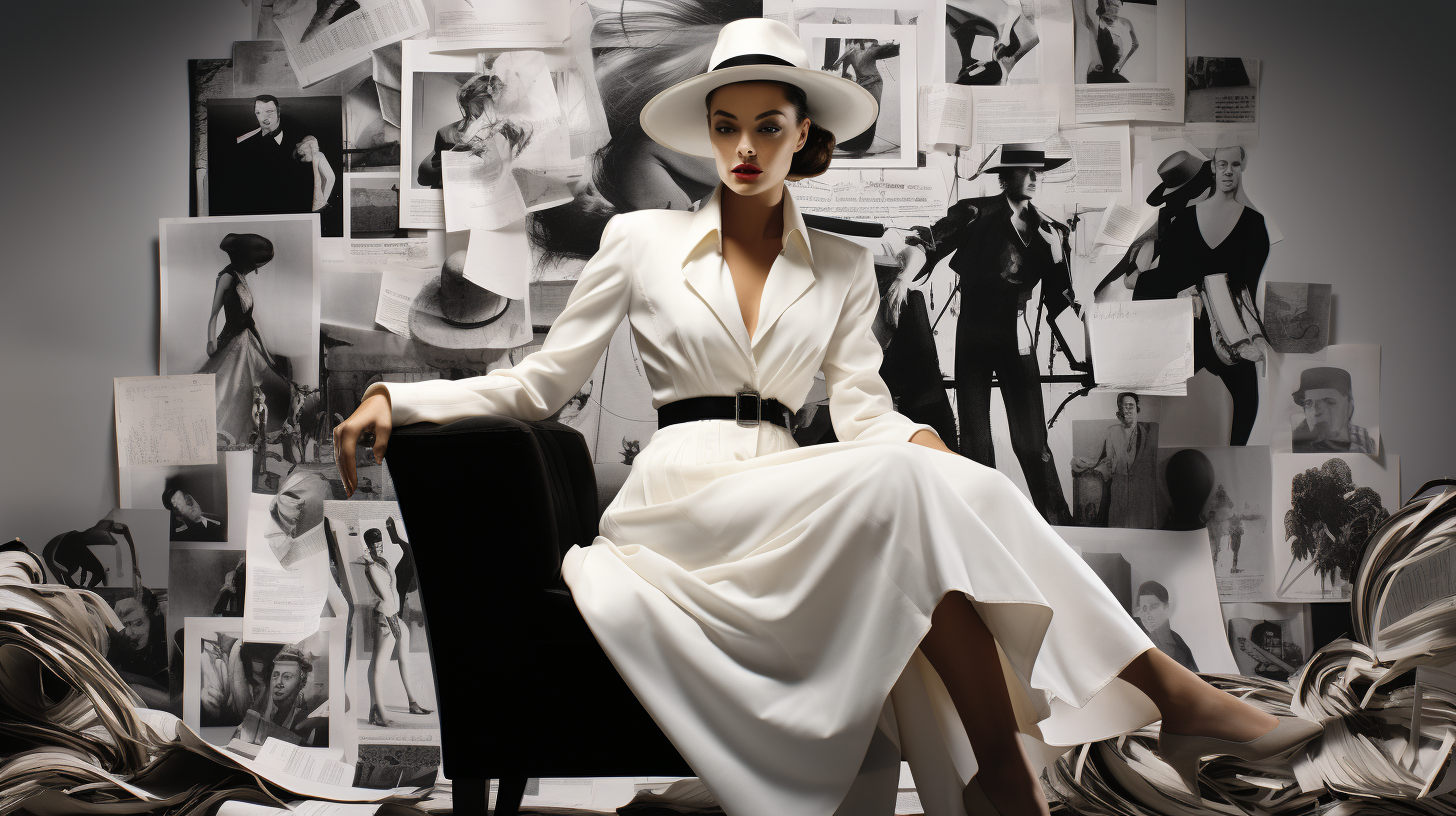
[an elegant montage featuring the iconic women of the 1940s against a backdrop of monochrome sketches of their signature styles. The central figure is a poised woman in a tailored suit, reminiscent of Bacall, her gaze confident and direct. Flanking her are portraits of Hepburn in wide-leg trousers, Schiaparelli with a bold hat, and McCardell draped in a functional yet chic dress. Each portrait captures the essence of their impact on fashion, their expressions reflecting the boldness and resilience of the era.]
International Influences: The Cross-Cultural Exchange
The 1940s fashion scene was not just a product of the times; it was a mosaic of international relations, a cross-cultural exchange that stitched the world a bit closer together through the threads of style.
Wartime Alliances Influencing Style
The alliances formed during the war didn’t just exist in the political arena; they permeated the fashion world. Military uniforms influenced civilian attire, introducing sharp tailoring and structured designs that spoke of strength and camaraderie among nations.
Exotic Inspirations and Cultural Appropriation
As the world grew smaller, so did the distance between cultural styles. Exotic prints and fabrics once seen as foreign curiosities began to weave their way into Western wardrobes, albeit not without controversy. The conversation around cultural appropriation versus appreciation began to take form, a discussion that’s still fervently debated today.
European Impacts on American Fashion
Parisian elegance, long the bastion of high fashion, found a new audience across the Atlantic. The U.S., previously seen as a fashion follower, started to take cues from the war-touched elegance of Europe, blending resilience with the refinement that the Old World was revered for.
Post-War Globalization of Style
Post-war, as barriers began to crumble, fashion became one of the earliest harbingers of globalization. Styles didn’t just cross borders—they obliterated them. The spread of American movies and music carried with it a new uniform of cool that resonated in streets from London to Tokyo, sealing fashion’s role as a global messenger.
Photorealistic Image Description
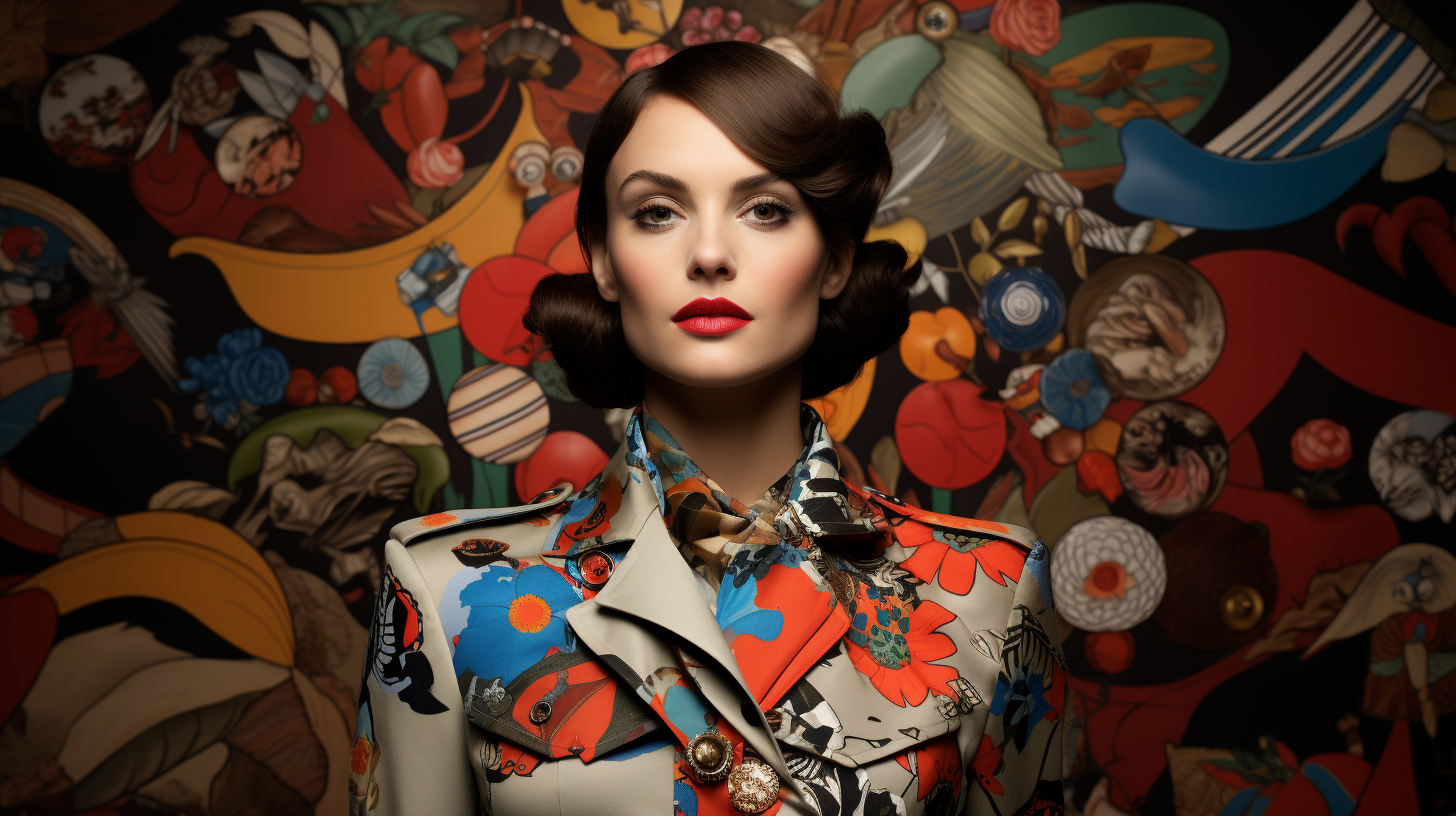
[a composite image capturing the essence of global fashion exchange. At the forefront, a woman stands in a smart, military-inspired suit with bold shoulder pads, symbolizing the wartime influences. Around her swirl accents from around the world: a silk kimono sash, a beret poised with Parisian flair, and bold tribal prints—all converging in a harmonious yet complex tableau that encapsulates the era’s eclectic influence.]
Conclusion
As the tumultuous waves of the 1940s settled, they left behind a shoreline rich with the remnants of a transformative era in women’s fashion. This was not merely a change in style but a revolution that rippled through the fabric of society, echoing into the present day.
Reflecting on the Evolution from Utility to Beauty
The journey from the austerity of wartime utility to the opulence of post-war beauty traces the resilience and adaptability of women. It mirrors a world in flux, a society grappling with unprecedented change, and a fashion industry that rose from the ashes of conflict with a renewed sense of creativity and innovation.
The Enduring Legacy of 1940s Women’s Fashion
The legacy of 1940s women’s fashion is not confined to vintage photographs or costume parties. It’s etched in the sharp lines of a tailored suit that speaks of empowerment, in the liberated swing of a full skirt, and in the boldness of a shoulder pad. These are not just stylistic choices but historical landmarks that chronicle our journey.
Lessons from History: The Relevance to Contemporary Fashion
The echoes of the 1940s continue to whisper through contemporary fashion corridors, reminding us that style is cyclical and eternal. The challenges faced, the ingenuity sparked by necessity, and the sheer audacity of transformation provide a blueprint for modern designers and fashion aficionados alike.
Inviting Reader Reflection and Engagement
As we button up this exploration, it’s an invitation to readers to look at their wardrobes as more than a collection of fabrics and threads. Each piece is a narrative, a stitch in time that connects us to a rich tapestry of history. We wear not just clothes but stories, legacies, and, perhaps most poignantly, the enduring spirit of an era that redefined what it means to dress.
With the final thread in place, we conclude our foray into the world of 1940s women’s fashion. From the silhouette-defining lines of utility wear to the luxurious excess of the ‘New Look,’ we’ve traced the contour of a decade that continues to shape our sartorial choices. No further sections remain; the narrative is complete, a story sewn from past to present, inviting us to wear our history with pride and knowledge.


